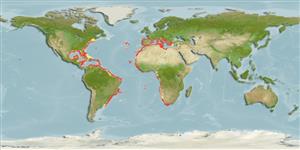Common names from other countries
Environment: milieu / climate zone / depth range / distribution range
Ecologia
; intervalo de profundidade 10 - 682 m (Ref. 62709). Tropical; 46°N - 38°S, 98°W - 37°E
Atlantic Ocean and the Mediterranean: from USA (Massachusetts, and Virginia to south Florida), West Indies, Central America and Brazil (Rio de Janeiro to Rio Grande do Sul) to Western Africa, including Canary and Madeira Islands, to Mediterranean Sea, and northeastern Atlantic from Spain to Portugal. Temperate to tropical.
Length at first maturity / Tamanho / Peso / Idade
Maturity: Lm ? range ? - ? cm Max length : 1.5 cm CW macho/indeterminado; (Ref. 93549)
Carapace width range: 1.22 to 1.47 cm (Ref. 93549). Maximum depth from 95880. Found on moderate depths from 10 to 679 m on mud, muddy sand, sandy and muddy detritus, coralline algae, calcareous algae, slightly sandy mud with funiculines, alcyonarians in mud, and reddish gravel with shell debris (Ref. 62709). In general, members of the family Homolidae are carnivorous (Ref. 107107).
Life cycle and mating behavior
Maturidade | Reprodução | Desova | Ovos | Fecundidade | Larvas
Members of the order Decapoda are mostly gonochoric. Mating behavior: Precopulatory courtship ritual is common (through olfactory and tactile cues); usually indirect sperm transfer.
Coelho Filho, P.A. 2004. (Ref. 2364)
Categoria na Lista Vermelha da IUCN (Ref. 130435)
Categoria CITES (Ref. 108899)
Not Evaluated
Not Evaluated
Utilização humana
| FishSource |
Ferramentas
Mais informação
Idade/Tamanho
Crescimento
Comprimento-peso
Comprimento-comprimento
Morfologia
Larvas
Abundância
Fontes da internet
Estimates based on models
Preferred temperature
(Ref.
115969): 12.2 - 23.2, mean 15.2 (based on 354 cells).
Categoria de preço
Unknown.
